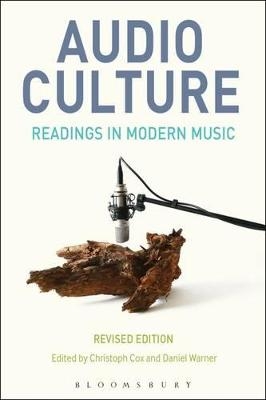
Audio Culture, Revised Edition
Bloomsbury Academic USA (Verlag)
978-1-5013-1836-8 (ISBN)
This new and expanded edition of the Audio Culture contains twenty-five additional essays, including four newly-commissioned pieces. Taken as a whole, the book explores the interconnections among such forms as minimalism, indeterminacy, musique concrète, free improvisation, experimental music, avant-rock, dub reggae, ambient music, hip hop, and techno via writings by philosophers, cultural theorists, and composers. Instead of focusing on some "crossover" between "high art" and "popular culture," Audio Culture takes all these musics as experimental practices on par with, and linked to, one another. While cultural studies has tended to look at music (primarily popular music) from a sociological perspective, the concern here is philosophical, musical, and historical.
Audio Culture includes writing by some of the most important musical thinkers of the past half-century, among them John Cage, Brian Eno, Ornette Coleman, Pauline Oliveros, Maryanne Amacher, Glenn Gould, Umberto Eco, Jacques Attali, Simon Reynolds, Eliane Radigue, David Toop, John Zorn, Karlheinz Stockhausen, and many others. Each essay has its own short introduction, helping the reader to place the essay within musical, historical, and conceptual contexts, and the volume concludes with a glossary, a timeline, and an extensive discography.
Christoph Cox is Professor of Philosophy at Hampshire College, USA. He is the author of Sonic Flux: Sound, Art, and Metaphysics and Nietzsche: Naturalism and Interpretation, and co-editor of Realism Materialism Art. Daniel Warner is Professor of Music at Hampshire College, USA. He is a composer, electronic artist, and author of Live Wires: A History of Electronic Music.
Acknowledgments
Introduction
Part One: Theories
I. Music and Its Others: Noise, Sound, Silence
Introduction
1. Jacques Attali, “Noise and Politics”
2. Luigi Russolo, “The Art of Noises: Futurist Manifesto”
3. Edgard Varèse, “The Liberation of Sound”
4. Henry Cowell, “The Joys of Noise”
5. John Cage, “The Future of Music: Credo”
6. R. Murray Schafer, “The Music of the Environment”
7. Anne Carson, “The Gender of Sound”
8. Drew Daniel, “Queer Sound”
9. Kevin Quashie, “The Quiet of Blackness: Miles Davis and John Coltrane”
II. Modes of Listening
Introduction
10. Marshall McLuhan, “Visual and Acoustic Space”
11. Pierre Schaeffer, “Acousmatics”
12. Francisco Lopez, “Profound Listening and Environmental Sound Matter”
13. Brian Eno, “Ambient Music”
14. Pauline Oliveros, “Auralizing the Sonosphere”
15. Maryanne Amacher, “Perceptual Geography: Third Ear Music and Structure Borne Sound”
16. Evelyn Glennie, “Hearing Essay”
17. Iain Chambers, “The Aural Walk”
18. Annahid Kassabian, “Ubiquitous Listening”
19. Lawrence Abu Hamdan, “Forensic Listening”
20. Ultra-red, “Organizing the Silence”
III. Music in the Age of Electronic Reproduction
Introduction
21. Glenn Gould, “The Prospects of Recording”
22. Brian Eno, “The Studio as Compositional Tool”
23. John Oswald, “Bettered by the Borrower: The Ethics of Musical Debt”
24. Chris Cutler, “Plunderphonia”
25. Kodwo Eshun, “Operating System for the Redesign of Sonic Reality”
26. Kenneth Goldsmith, “Six File-Sharing Epiphanies”
27. Tara Rodgers, “Cultivating Activist Lives in Sound”
Part Two: Practices
IV. The Open Work
Introduction
28. Umberto Eco, “Poetics of the Open Work”
29. John Cage, “Composition as Process: Indeterminacy”
30. Christoph Cox, “Every Sound You Can Imagine: On Graphic Scores”
31. Earle Brown, “Transformations and Developments of a Radical Aesthetic”
32. John Zorn, “The Game Pieces”
33. Anthony Braxton, “Introduction to Catalog of Works”
34. Lawrence “Butch” Morris, “Notes on Conduction”
V. Experimental Musics
Introduction
35. Michael Nyman, “Towards (a Definition of) Experimental Music”
36. John Cage, “Introduction to Themes & Variations”
37. Brian Eno, “Generating and Organizing Variety in the Arts”
38. Cornelius Cardew, Scratch Music Draft Constitution
39. David Toop, “The Generation Game: Experimental Music and Digital Culture”
40. Jennifer Walshe on “The New Discipline”
41. Yan Jun, “Re-Invent: Experimental Music in China”
VI. Improvised Musics
Introduction
42. Ornette Coleman, “Change of the Century”
43. Wadada Leo Smith, “Notes (8 Pieces): Creative Music”
44. Derek Bailey, “Free Improvisation”
45. Frederic Rzewski, “Little Bangs: A Nihilist Theory of Improvisation”
46. George E. Lewis, “Improvised Music After 1950: Afrological and Eurological Perspectives”
47. Vijay Iyer, “Improvisation: Terms and Conditions”
48. Mattin, “Going Fragile”
49. Trio Sowari et al., “27 Questions For a Start … And Some Answers to Begin With”
VII. Minimalisms
Introduction
50. Kyle Gann, “Thankless Attempts at a Definition of Minimalism”
51. Wim Mertens, “Basic Concepts of Minimal Music”
52. Steve Reich, “Music as a Gradual Process”
53. La Monte Young and Marian Zazeela, “Conversation with Richard Kostelanetz”
54. Tony Conrad, “LYssophobia: On Four Violins”
55. Susan McClary, “Rap, Minimalism and Structures of Time in Late Twentieth-Century Culture”
56. Philip Sherburne, “Draw a Straight Line and Follow It: Minimalism in Contemporary Electronic Dance Music”
VIII. DJ Culture
Introduction
57. László Moholy-Nagy, “Production–Reproduction: Potentialities of the Phonograph”
58. Situationist International, “Détournement as Negation and Prelude”
59. William S. Burroughs, “The Invisible Generation”
60. Paul D. Miller, “Algorithms: Erasures and the Art of Memory”
61. David Toop, “Replicant: On Dub”
62. Simon Reynolds, “Post-Rock”
63. Marina Rosenfeld, “A Few Notes on Production and Playback”
IX. Electronic Music and Electronica
Introduction
64. Jacques Barzun, “Introductory Remarks to a Program of Works Produced at the Columbia-Princeton Electronic Music Center”
65. Karlheinz Stockhausen, “Electronic and Instrumental Music”
66. Karlheinz Stockhausen et al., “Stockhausen vs. the Technocrats”
67. Eliane Radigue, “The Mysterious Power of the Infinitesimal”
68. Kim Cascone, “The Aesthetics of Failure: ‘Post-Digital’ Tendencies in Contemporary Computer Music”
69. Holly Herndon, “Laptop Intimacy and Platform Politics”
Bibliography
Chronology
Discography
Glossary
Index of Quotations
Index
| Erscheinungsdatum | 18.08.2017 |
|---|---|
| Verlagsort | New York |
| Sprache | englisch |
| Maße | 152 x 229 mm |
| Gewicht | 932 g |
| Themenwelt | Kunst / Musik / Theater ► Musik ► Musikgeschichte |
| Kunst / Musik / Theater ► Musik ► Musiktheorie / Musiklehre | |
| Sozialwissenschaften | |
| ISBN-10 | 1-5013-1836-5 / 1501318365 |
| ISBN-13 | 978-1-5013-1836-8 / 9781501318368 |
| Zustand | Neuware |
| Informationen gemäß Produktsicherheitsverordnung (GPSR) | |
| Haben Sie eine Frage zum Produkt? |
aus dem Bereich


